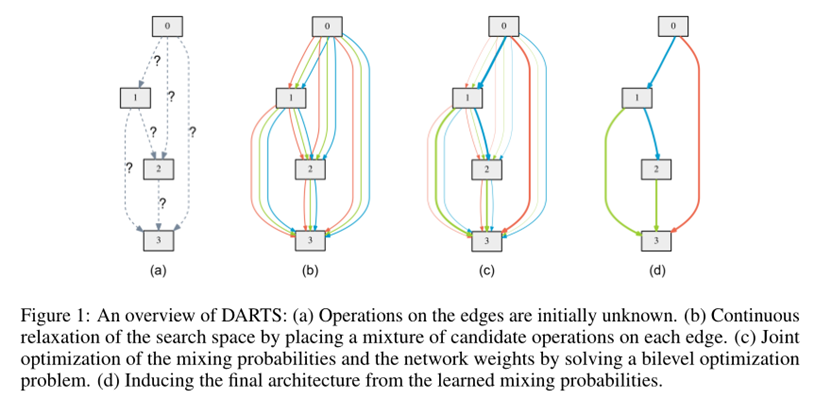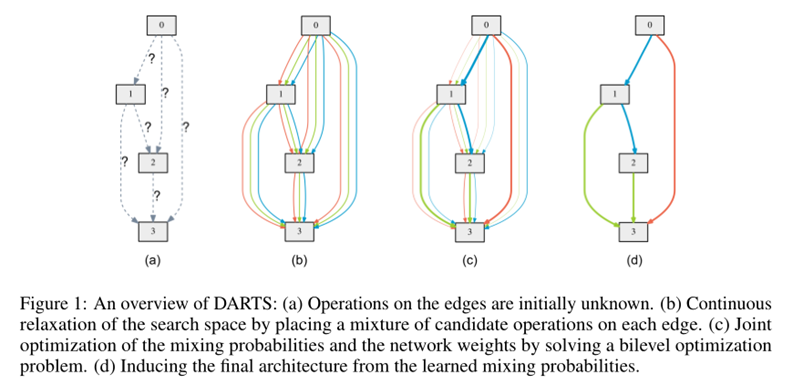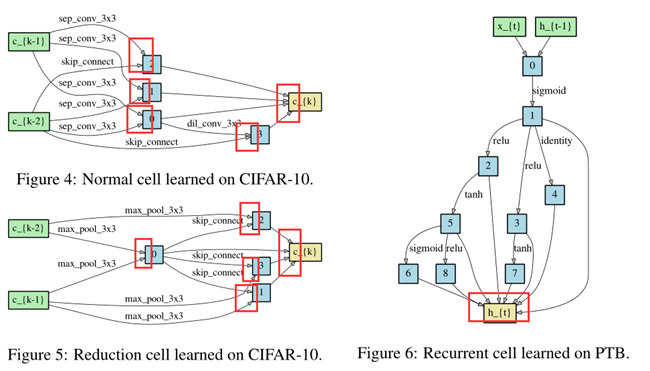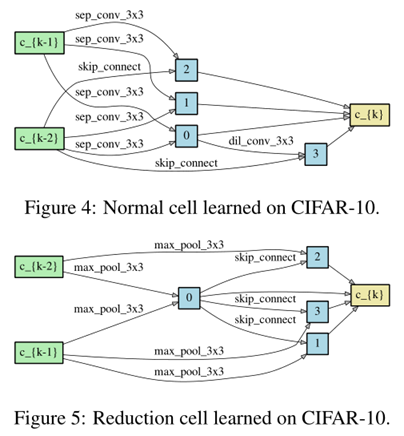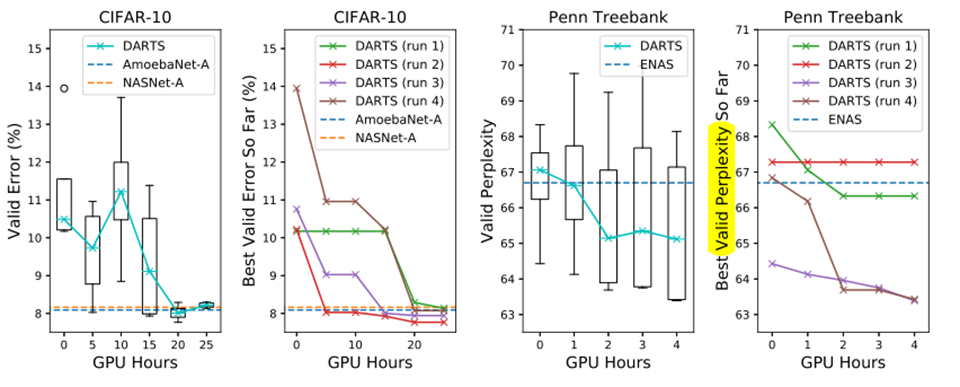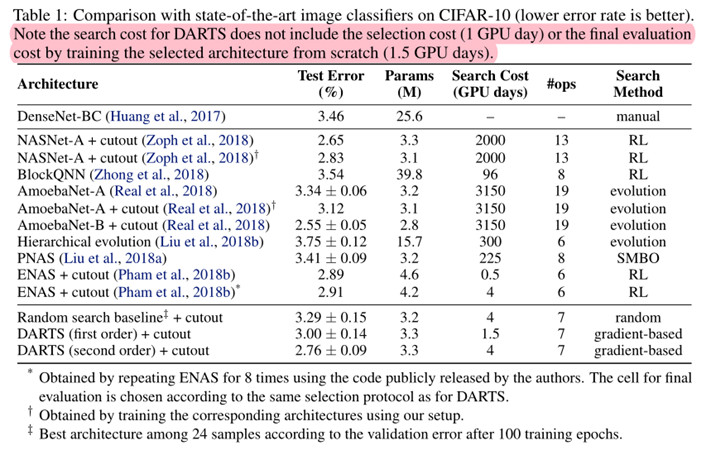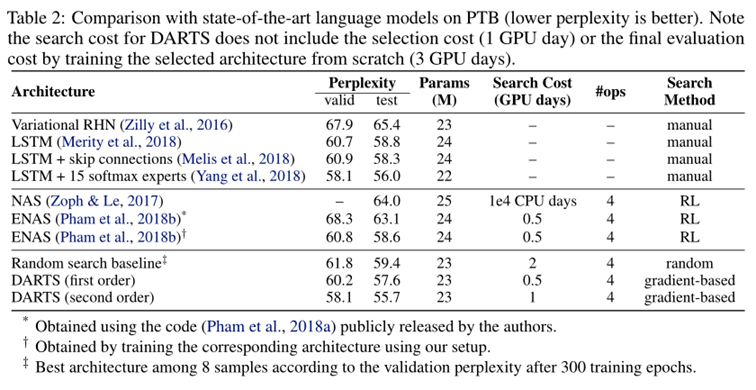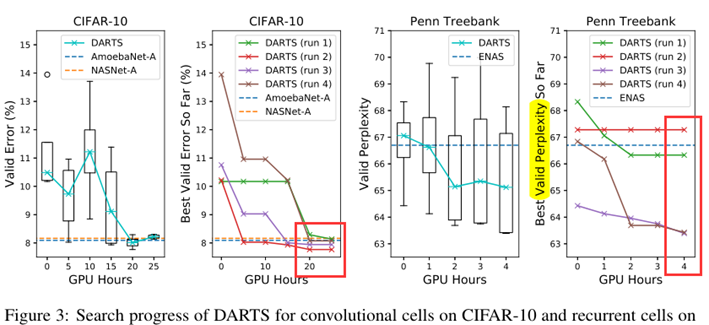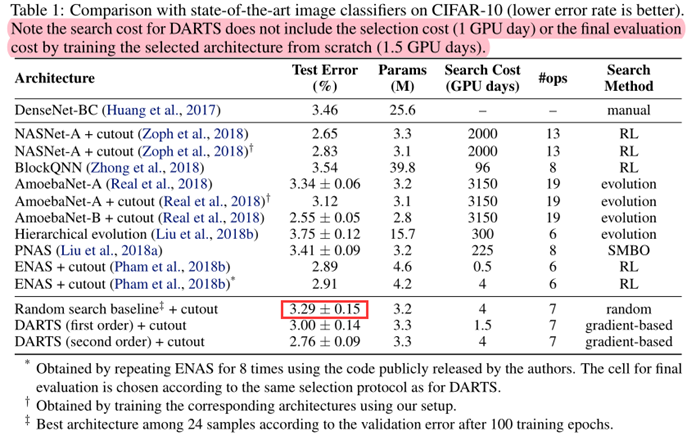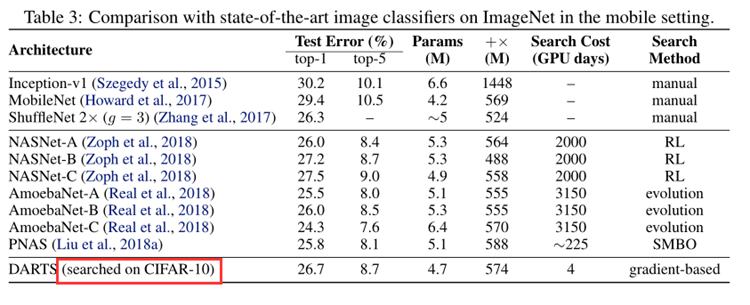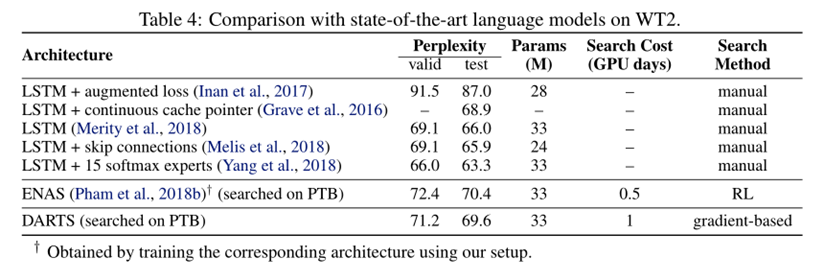2019-ICLR-DARTS: Differentiable Architecture Search-论文阅读
DARTS
2019-ICLR-DARTS Differentiable Architecture Search
- Hanxiao Liu、Karen Simonyan、Yiming Yang
- GitHub:2.8k stars
- Citation:557
Motivation
Current NAS method:
- Computationally expensive: 2000/3000 GPU days
- Discrete search space, leads to a large number of architecture evaluations required.
Contribution
- Differentiable NAS method based on gradient decent.
- Both CNN(CV) and RNN(NLP).
- SOTA results on CIFAR-10 and PTB.
- Efficiency: (2000 GPU days VS 4 GPU days)
- Transferable: cifar10 to ImageNet, (PTB to WikiText-2).
Method
Search Space
Search for a cell as the building block of the final architecture.
The learned cell could either be stacked to form a CNN or recursively connected to form a RNN.
A cell is a DAG consisting of an ordered sequence of N nodes.
\(\bar{o}^{(i, j)}(x)=\sum_{o \in \mathcal{O}} \frac{\exp \left(\alpha_{o}^{(i, j)}\right)}{\sum_{o^{\prime} \in \mathcal{O}} \exp \left(\alpha_{o^{\prime}}^{(i, j)}\right)} o(x)\)
\(x^{(j)}=\sum_{i<j} o^{(i, j)}\left(x^{(i)}\right)\)
Optimization Target
Our goal is to jointly learn the architecture α and the weights w within all the mixed operations (e.g. weights of the convolution filters).
\(\min _{\alpha} \mathcal{L}_{v a l}\left(w^{*}(\alpha), \alpha\right)\) ......(3)
s.t. \(\quad w^{*}(\alpha)=\operatorname{argmin}_{w} \mathcal{L}_{\text {train}}(w, \alpha)\) .......(4)
The idea is to approximate w∗(α) by adapting w using only a single training step, without solving the inner optimization (equation 4) completely by training until convergence.
\(\nabla_{\alpha} \mathcal{L}_{v a l}\left(w^{*}(\alpha), \alpha\right)\) ......(5)
\(\approx \nabla_{\alpha} \mathcal{L}_{v a l}\left(w-\xi \nabla_{w} \mathcal{L}_{t r a i n}(w, \alpha), \alpha\right)\) ......(6)
- When ξ = 0, the second-order derivative in equation 7 will disappear.
- ξ = 0 as the first-order approximation,
- ξ > 0 as the second-order approximation.
Discrete Arch
To form each node in the discrete architecture, we retain the top-k strongest operations (from distinct nodes) among all non-zero candidate operations collected from all the previous nodes.
we use k = 2 for convolutional cells and k = 1 for recurrent cellsThe strength of an operation is defined as \(\frac{\exp \left(\alpha_{o}^{(i, j)}\right)}{\sum_{o^{\prime} \in \mathcal{O}} \exp \left(\alpha_{o^{\prime}}^{(i, j)}\right)}\)
Experiments
We include the following operations in O:
- 3 × 3 and 5 × 5 separable convolutions,
- 3 × 3 and 5 × 5 dilated separable convolutions,
- 3 × 3 max pooling,
- 3 × 3 average pooling,
- identity (skip connection?)
- zero.
All operations are of
- stride one (if applicable)
- the feature maps are padded to preserve their spatial resolution.
We use the
- ReLU-Conv-BN order for convolutional operations,
- Each separable convolution is always applied twice
- Our convolutional cell consists of N = 7 nodes, the output node is defined as the depthwise concatenation of all the intermediate nodes (input nodes excluded).
The first and second nodes of cell k are set equal to the outputs of cell k−2 and cell k−1
Cells located at the 1/3 and 2/3 of the total depth of the network are reduction cells, in which all the operations adjacent to the input nodes are of stride two.
The architecture encoding therefore is (αnormal, αreduce),
where αnormal is shared by all the normal cells
and αreduce is shared by all the reduction cells.
To determine the architecture for final evaluation, we run DARTS four times with different random seeds and pick the best cell based on its validation performance obtained by training from scratch for a short period (100 epochs on CIFAR-10 and 300 epochs on PTB).
This is particularly important for recurrent cells, as the optimization outcomes can be initialization-sensitive (Fig. 3)
Arch Evaluation
- To evaluate the selected architecture, we randomly initialize its weights (weights learned during the search process are discarded), train it from scratch, and report its performance on the test set.
- To evaluate the selected architecture, we randomly initialize its weights (weights learned during the search process are discarded), train it from scratch, and report its performance on the test set.
Result Analysis
- DARTS achieved comparable results with the state of the art while using three orders of magnitude less computation resources.
- (i.e. 1.5 or 4 GPU days vs 2000 GPU days for NASNet and 3150 GPU days for AmoebaNet)
- The longer search time is due to the fact that we have repeated the search process four times for cell selection. This practice is less important for convolutional cells however, because the performance of discovered architectures does not strongly depend on initialization (Fig. 3).
- It is also interesting to note that random search is competitive for both convolutional and recurrent models, which reflects the importance of the search space design.
Results in Table 3 show that the cell learned on CIFAR-10 is indeed transferable to ImageNet.
The weaker transferability between PTB and WT2 (as compared to that between CIFAR-10 and ImageNet) could be explained by the relatively small size of the source dataset (PTB) for architecture search.
The issue of transferability could potentially be circumvented by directly optimizing the architecture on the task of interest.
Conclusion
- We presented DARTS, a simple yet efficient NAS algorithm for both CNN and RNN.
- SOTA
- efficiency improvement by several orders of magnitude.
Improve
- discrepancies between the continuous architecture encoding and the derived discrete architecture. (softmax…)
- It would also be interesting to investigate performance-aware architecture derivation schemes based on the shared parameters learned during the search process.
Appendix
2019-ICLR-DARTS: Differentiable Architecture Search-论文阅读的更多相关文章
- 论文笔记:DARTS: Differentiable Architecture Search
DARTS: Differentiable Architecture Search 2019-03-19 10:04:26accepted by ICLR 2019 Paper:https://arx ...
- 论文笔记系列-DARTS: Differentiable Architecture Search
Summary 我的理解就是原本节点和节点之间操作是离散的,因为就是从若干个操作中选择某一个,而作者试图使用softmax和relaxation(松弛化)将操作连续化,所以模型结构搜索的任务就转变成了 ...
- 论文笔记:Progressive Differentiable Architecture Search:Bridging the Depth Gap between Search and Evaluation
Progressive Differentiable Architecture Search:Bridging the Depth Gap between Search and Evaluation ...
- 2019-ICCV-PDARTS-Progressive Differentiable Architecture Search Bridging the Depth Gap Between Search and Evaluation-论文阅读
P-DARTS 2019-ICCV-Progressive Differentiable Architecture Search Bridging the Depth Gap Between Sear ...
- 论文笔记系列-Auto-DeepLab:Hierarchical Neural Architecture Search for Semantic Image Segmentation
Pytorch实现代码:https://github.com/MenghaoGuo/AutoDeeplab 创新点 cell-level and network-level search 以往的NAS ...
- Research Guide for Neural Architecture Search
Research Guide for Neural Architecture Search 2019-09-19 09:29:04 This blog is from: https://heartbe ...
- 小米造最强超分辨率算法 | Fast, Accurate and Lightweight Super-Resolution with Neural Architecture Search
本篇是基于 NAS 的图像超分辨率的文章,知名学术性自媒体 Paperweekly 在该文公布后迅速跟进,发表分析称「属于目前很火的 AutoML / Neural Architecture Sear ...
- 论文笔记系列-Neural Architecture Search With Reinforcement Learning
摘要 神经网络在多个领域都取得了不错的成绩,但是神经网络的合理设计却是比较困难的.在本篇论文中,作者使用 递归网络去省城神经网络的模型描述,并且使用 增强学习训练RNN,以使得生成得到的模型在验证集上 ...
- 论文笔记:Auto-DeepLab: Hierarchical Neural Architecture Search for Semantic Image Segmentation
Auto-DeepLab: Hierarchical Neural Architecture Search for Semantic Image Segmentation2019-03-18 14:4 ...
随机推荐
- 用纯css、JavaScript、jQuery简单的轮播图
完成一个可以自动切换或点击数字的轮播图 HTML代码只需要一个div 包含着一个图片和一个列表,我们主要的思路就是通过点击相应的数字,改变图片的 路径. 有4张图片都在img文件夹里,名称为 img ...
- 抓住CoAP协议的“心”
摘要 The Constrained Application Protocol(CoAP)是一种专用的Web传输协议,用于受约束的节点和受约束的(例如,低功率,有损)网络. 节点通常具有带少量ROM和 ...
- 你应该知道的Vue高级特性
本文使用的Vue版本:2.6.10 Vue为我们提供了很多高级特性,学习和掌握它们有助于提高你的代码水平. 一.watch进阶 从我们刚开始学习Vue的时候,对于侦听属性,都是简单地如下面一般使用: ...
- 王颖奇 201771010129《面向对象程序设计Java》第十八周实验总结
实验十八 总复习 实验时间 2018-12-30 1.实验目的与要求 (1) 综合掌握java基本程序结构: (2) 综合掌握java面向对象程序设计特点: (3) 综合掌握java GUI 程序设 ...
- python3语法学习第五天--函数(1)
函数:函数能提高应用的模块性,和代码的重复利用率,是一段可重复使用的代码块 自定义函数: 1.函数代码块以 def 关键词开头,后接函数标识符名称和圆括号 (). 2.任何传入参数和自变量必须放在圆括 ...
- [hdu4710 Balls Rearrangement]分段统计
题意:求∑|i%a-i%b|,0≤i<n 思路:复杂度分析比较重要,不细想还真不知道这样一段段跳还真的挺快的=.= 令p=lcm(a,b),那么p就是|i%a-i%b|的循环节.考虑计算n的答案 ...
- 03JAVA循环结构
和JS\Python语句判断逻辑基本一致,不需要记录详细,只需要记录格式 一.for循环 for (初始化数据;判断语句:控制语句){ 循环体语句; } 二.while循环 初始化数据; while ...
- angular 实现依赖注入
1:首先获取module对象var myAppModule = angular.module('myApp', []); 2:定义对象(类似spring中xml声明bean对象<bean id= ...
- Oracle细粒度审计
场景 管理信息化应用,想审计某张表的数据是否做了删除.Oracle中专门有自带的函数.可以满足这个需求 1.查询审计日志的语句 select timestamp, db_user, os_user, ...
- 虚拟机安装配置(VMware与CentOS安装)
VMware下载地址: https://www.vmware.com/cn/products/workstation-pro/workstation-pro-evaluation.html centO ...

